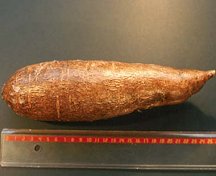Previous Page | Right click this page to print.
Roots and tubers
Roots and tubers are a group of animal feedstuffs. In general, roots and tubers are by-products of the foods as produced for human consumption. Technically, a root is defined as a fleshy, subterranean portion of a plant and a tuber is defined as a short, thick, fleshy stem, or terminal portion of a stem or rhizome, usually subterranean. However, as their nutritional characteristics are similar, roots and tubers will be discussed as one in the lecture. Roots and tubers used as animal feedstuffs include potatoes, turnips, cassava, mangolds, swedes, beets, carrots, and parsnips. Root crops may either be grazed or harvested and delivered to confined animals. Nutritionally, root and tubers are high in water; the water concentration ranges between 75-90%. On a dry-matter basis, roots and tubers are a good energy source. Roots and tubers are high in nonstructural carbohydrates. The nonstructural carbohydrates are digestible by both ruminants and nonruminants. The crude protein and crude fiber content ranges from 4-12% and 5-11%, respectively. Roots and tubers are also high in potassium and low in calcium and phosphorus. Typically, the amount of roots and tubers fed should be limited to replacing 25% of the grain in the ration. In general, roots and tubers are mostly fed to ruminants. The following section will discuss in more detail a couple of the popular roots and tubers.
In the U.S., cull, surplus, and small potatoes and potato by-products are used as feedstuffs. Technically, potatoes are a tuber. Raw potatoes are 78-89% water. On a dry-matter basis, potatoes are a high energy feedstuff. The nitrogen-free extract concentration is 82-83%. The primary carbohydrate is starch. On a dry-matter basis, the crude protein and crude fiber concentrations are 10-11% and 4%, respectively. Processing improves the nutritional value of potatoes. Cooking improves nutrient digestibility and feedstuff palatability and destroys some inhibitors. For ruminants, potatoes may either be consumed raw or cooked. For monogastrics, potatoes should be processed to improve nutritional value. For ruminants, potatoes are limited to approximately 50% of the dry-matter. For monogastrics, processed potatoes are limited to a lesser amount. Sprouted, green, and frozen potatoes should not be fed. In addition to potatoes, a number of by-products of potato processing are available as animal feedstuffs including potato meal, slurry, filter cake, flakes, pulp, and dried by-products. High moisture potato by-products have also been combined with other feedstuffs and ensiled.
Cassava is a tropical crop. Cassava meal is produced from the cassava root.
Figure 5.10 illustrates a cassava root.

In the U.S., the primary cassava feedstuff is dried cassava meal. Dried cassava meal is high energy, low protein feedstuff. The dried product is 83% nitrogen-free extract. The nutritional composition of fresh cassava root is 65% water, 30% nitrogen-free extract. The crude protein and crude fiber in both products is negligible. Cassava meal can be fed to both ruminants and nonruminants. The woody stems and large leaves of a cassava plant may be fed as a forage to ruminants. The fresh plant must be processed. The fresh cassava leaves and roots may be high in cyanogenic glycosides. Cyanogenic glycosides are toxic.
Previous Page | Right click this page to print.